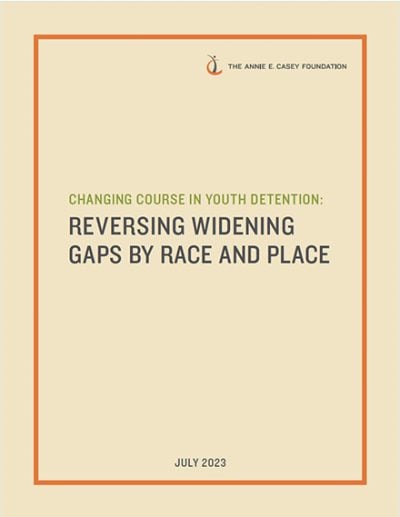Black Youth at Higher Risk of Being Detained
Black youth were almost 10 times more likely to be detained than their white peers on January 1, 2023. Prior to the pandemic, Black youth were detained at more than six times the rate of white youth.

The Annie E. Casey Foundation has found large and widening gaps in youth detention by race and place in its three-year analysis of the effects of the coronavirus pandemic on juvenile justice systems. When it comes to the odds of being detained, young people in the United States live in different worlds, depending on their race and the region and jurisdiction where they reside. The disproportionate use of detention for Black youth — already distressingly high before the pandemic — has increased. Also, over that three-year period, where youth lived mattered to a greater extent to their odds of being detained than it did before.
The data from Casey’s monthly survey offer an unparalleled glimpse into what’s been happening in juvenile justice systems around the country over the past three years. Nationwide, youth detention fell sharply at the start of the COVID-19 pandemic; largely held at that low level for a year; and then steadily returned to its pre-pandemic level. After falling by as much as 30% in the first few months of the pandemic, the number of youth held in juvenile detention in survey sites on January 1, 2023 (3,436 young people), rose to almost exactly the level reported on January 1, 2020 (3,410 young people) — and was rapidly increasing.
Beneath the surface of that simple story, the Foundation observed significant and concerning changes, especially for Black youth:
These findings are a cause for alarm. In addition to being an ineffective response to crime, detention poses concrete dangers to young people. Even a short stay in detention has been associated with serious harm to a youth's mental and physical well-being, stifled education and employment prospects and further justice system involvement. Such dangers grow even more acute when detention centers lack sufficient well-trained staff.
Context matters. This survey occurred during a tumultuous three-year period, marred by the deadly and disruptive COVID-19 pandemic; nationwide racial justice protests; highly contentious school closures and reopenings; the erosion of public trust in institutions; a sobering rise in mass casualties by firearms; and increasing levels of mental health distress, especially for young people. Against that backdrop, it would be easy to assume that the growth in youth detention is just one more symptom of a society under stress — a regrettable but inevitable sign of the times.
But higher detention populations are not inevitable — and the evidence for this is in the findings themselves. A third of the jurisdictions the Foundation studied have sustained and deepened reductions in detention by almost 30% below their pre-pandemic levels. Their continuing success over the past three years affirms that substantial reforms remain possible even in challenging times, when the reforms are pursued with sustained urgency and attention.
The data from this survey strongly suggest that the juvenile justice system has emerged from the pandemic era profoundly changed, and in ways that should leave us all deeply concerned and motivated to do better. The surge in the use of youth detention in many parts of the country and the huge and growing racial disparities everywhere are crises that demand immediate action from youth justice system leaders.
These trends are reversible if youth justice leaders heed the research and evidence of what works to help young people reach their potential — especially young people facing steep obstacles to success. Removing youth from their homes and routines and isolating them from their natural support systems make things worse, not better.
The following recommendations highlight actions that juvenile justice systems can take — and many are taking — to align policies and practices to ensure young people are detained only as a last resort and no longer than necessary:
These actions could improve safety and opportunity in our communities, fairness and efficacy in our justice system, and prospects for a brighter future for our children.
When it comes to the odds of being detained, young people in the United States live in different worlds depending on their race as well as the region and jurisdiction where they reside. The disproportionate use of detention for Black youth — already distressingly high before the pandemic — has increased. In addition, where youth lived impacted their risk of detainment more than before the pandemic.
These findings sound an alarm for the well-being of thousands of young people. Pretrial juvenile detention is an ineffective response to crime and poses concrete dangers to young people. Even a short detainment can harm a young people’s mental and physical well-being, hinder their education and employment prospects and increase their risk of further justice system involvement.
We hope you'll find value in this report. We’d love to get a little information from you, which we'll use to notify you about relevant new resources.